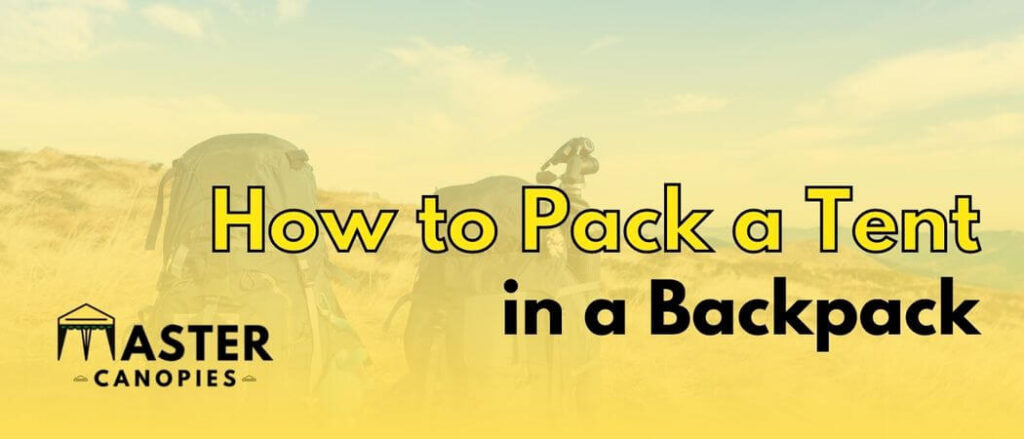
Can You Put a Tent in the Dryer Safely?
Can You Put a Tent in the Dryer Safely? Published February 4th, 2023 by Allen Campbell Well, it’s no secret that a tent is a
Published July 8th, 2022 by Allen Campbell

How many times have you been camping and had to figure out how to pack a tent in your backpack? It can be tricky, but with a little know-how, you can pack that tent like a pro and save some valuable room in your pack.
In this blog post, I’ll teach you how to pack a tent in a backpack safely so that you can enjoy your trip without having to worry about your gear.
According to my research, backpacks that include an internal frame are the best for camping. Internal frame backpacks offer more space and are better for carrying heavier loads, making them ideal for camping trips. Without worrying about your tent taking up valuable space, you can pack all of your gear inside your backpack with ease.
If you don’t have a backpack and tent, make sure to purchase both that are compatible with each other. This idea will save you money, time, and energy when packing for your next camping trip.
But if you have a larger-sized tent, you can use compression bags to compress your tent into a smaller size and then afterward, pack it inside your backpack with ease.
Lorem ipsum dolor sit amet, consectetur adipiscing elit, sed do eiusmod tempor incididunt ut labore et dolore magna aliqua. Ut enim ad minim veniam, quis nostrud exercitation ullamco laboris nisi ut aliquip ex ea commodo consequat. Duis aute irure dolor in reprehenderit in voluptate velit esse cillum dolore eu fugiat nulla pariatur. Excepteur sint occaecat cupidatat non proident, sunt in culpa qui officia deserunt mollit anim id est laborum.
If you want to avoid the extra weight on your shoulders then make sure to dry the tent out completely before you start packing it up. Wet tents add up the extra weight of water which could tire you out on your journey.
Once the tent is dry, take it down and place it along its full length on a plane surface. Keep the tent poles in their carrying case so they don’t become tangled up with the rest of your gear.
Place your tent poles bag on one end of the tent and then start rolling it up towards the other end. With the help of poles, you can keep rolling the tent much tighter. The tighter packing will allow for a smaller and more manageable roll, making it easier to carry when you’re on the go.
While doing so, make sure you are rolling it as evenly and compactly as possible so that one side isn’t bulkier than the other. Once the tent is half-wrapped, add the tent pegs bag to your roll and continue wrapping.

Once you rolled up your tent nicely and tight, it’s time to put it away in the storage bag. Keeping everything compact will save you space for more essential items, and add central support.
Before you stuff your tent in your backpack and take off on your adventure, you’ll need to make sure you’re prepared. This includes some necessary items you’ll be having on your adventurous journey.
And most importantly, make sure to keep the heavier items at the bottom of your backpack and lighter items on the top.
Put your tent in the middle of your backpack so that it doesn’t shift around too much while you’re hiking. You don’t want the weight to be unevenly distributed, which can make it uncomfortable to carry your backpack.
Plus, if your tent is in the middle, it is less likely to give stress to your back and body because it is one of the heavier items that you’ll be carrying. I recommend adding your sleeping bag below the tent.
There are two options when you are stuffing your tent in your backpack – horizontal or vertical. Horizontal positions can be perfect if you’re looking to pack other items on top of the tent, while a vertical setup allows you to more easily pull it out from the backpack.
To pack an external frame backpack, you can use the same packing methods that you would use for an internal frame backpack. This means that you will still dry out your tent and roll it up tightly before packing it outside the backpack.
There is no big deal with an external frame backpack, the only thing to focus on is the right way of placing your tent. As the name suggests, the tent is hung on the external frame of the backpack, which makes it more comfortable and easily accessible.
Add your tent to the bottom of your backpack which is a great place for any extra weight you might be carrying. This will help to avoid any potential back problems on your hike.
In an External frame backpack, your tent is more prone to dangers outside of your control, such as getting wet in the rain or scratching against a tree.
Another problem with an external frame backpack is that there is the potential for your tent to fall off. This can leave you in trouble and even dangerous situations if you’re out in the wilderness. Make sure to secure your tent well to avoid this big issue.
Firstly, make sure that your tent is dry before you pack it up. If it’s even slightly damp, it can mildew and ruin your tent. Here are a few tips on how to dry out your tent:
–Shake it out: The first thing you can do to pamper your tent is give it a good shake after being in the water.
–Set it in the sun: If you have enough time, expose your tent to sunlight for a few hours to give it a thorough airing out and help kill any mildew spores.
–Use a fan: If you are short on time, then using a fan will help you get the job done quickly.
Pack a Tent in a Backpack Safely: It’s not as hard as you might think! If you take the time to learn how to pack your tent safely, it will make your next backpacking trip much more enjoyable.
Also, keep in mind the weight and size of your tent when selecting a backpack because you don’t want your shelter to be too big or too heavy for your backpacking trip. Choose a tent that strikes the perfect balance between weight and size so that you can enjoy your time in the great outdoors.
By following these simple steps, you can keep everything organized and be sure that your tent is protected while you are out on the trail.
If you are thinking to carry your tent in a backpack, size is an important factor you should keep in mind. According to needs and budget, there are plenty of tents on the market that is specifically designed to fit in a backpack and weigh less than three pounds.
These tents typically have smaller dimensions and can easily be compressed into a small bag. Whenever you are in the market for a backpack-friendly tent, always pay attention to the size specifications to be sure it will fit in your backpack comfortably.
When it comes to backpacking and packing a tent in a backpack, there is a lot of debate about what is considered heavy for a backpacking tent and it is often very subjective. While camping, every ounce in your backpack matters because you are carrying your shelter on your back.
So, everything comes down to your body type and how much you can carry. If your back can handle heavy loads, then you can easily take a six-pound tent. However, if you are looking for a lightweight option, you can find a different variety of tents starting from 2.5 pounds.
I am sure you have seen them before—the bungee strings/cords crisscrossing the front of many backpacks. They may look like they are just for show, but they serve an important function to make your journey easier.
Those strings are designed to help you secure your gear. If you have a jacket or an extra pair of socks that you need to keep with you, you can clip them onto the bungee strings and be confident they will not fall out.
The strings are also great for attaching other gear to your backpack, like a water bottle or a flashlight. So, next time you see those bungee strings, remember their purpose.
You might don’t know but backpacks with mesh back are very comfortable and practical, especially on hot days. The mesh fabric allows air to circulate, which helps to prevent sweat build-up and keeps you cool and comfortable. If you’re looking for a backpack that will help you stay comfortable on long hikes or busy days, look for one with mesh back padding.
You should store your backpack where it will be out of the way but still within easy reach and If there is a tree nearby, you can hang your backpack from a branch using a length of rope or cord. Hanging it from a tree also keeps your backpack off the ground and away from dirt and mud. There is another option which is to place your backpack under your tent vestibule. The result will be a clean and dry backpack that is close by if you need it during the night.
Water is the most important thing to pack when backpacking, but how much should you bring? It is obvious that you will need to drink water to stay hydrated, but you will also need water for cooking and washing up.
A general rule of thumb is that each person should plan to carry at least 2 liters of water. But this number will depend on the length of your hike, the weather conditions, and your level of physical activity.
For example, if you are hiking in hot weather or you expect to sweat a lot, you may want to bring more water. On the other hand, if you are hiking in cooler weather or you will have access to a water source, you may not need to carry as much.

Allen is a full time writer at Mastercanopies.com and enjoys traveling around the United States and exploring nature. He enjoys writing about canopies as he believes they are extremely crucial in having a successful camping trip whether it be a trip to the beach, mountains, or the open plains.

Can You Put a Tent in the Dryer Safely? Published February 4th, 2023 by Allen Campbell Well, it’s no secret that a tent is a

How to Print on a Canopy: How to Print Custom Images/Logos Published February 4th, 2023 by Allen Campbell Do you want to print something special

How to Choose the Best Outdoor Event Flooring for your Next Celebration Published January 31st, 2023 by Allen Campbell Planning an outdoor event can be

How to Insulate a Tent for Winter and Keep Warm Published February 3rd, 2023 by Allen Campbell Is your tent the last frontier when it

Wolfwise Beach Tent Review: Should You Buy It? Published January 23rd, 2023 by Allen Campbell Are you planning a beach vacation but don’t know exactly

How to Start a Tent Rental Business (and have Success with It!) Published January 23rd, 2023 by Allen Campbell Do you have a knack for

Wolfwise Beach Tent Instructions: Easy Setup Guide Published January 23rd, 2023 by Allen Campbell Let’s face it, setting up a beach tent can be tricky…

Best 100×100 Tents for Large Gatherings and Parties Published January 12th, 2023 by Allen Campbell Finding the right tent for your next event can be

Best Tent Rentals in Downers Grove, IL Published January 12th, 2023 by Allen Campbell Hoping to make a big impact in Downers Grove? Well, if

Master Canopies is here to bring you the best canopies for the outdoors so that you can enjoy the fresh air without the gleaming and burning light of the sun.

Master Canopies is here to bring you the best canopies for the outdoors so that you can enjoy the fresh air without the gleaming and burning light of the sun. As an Amazon Associate, we earn from qualifying purchases.